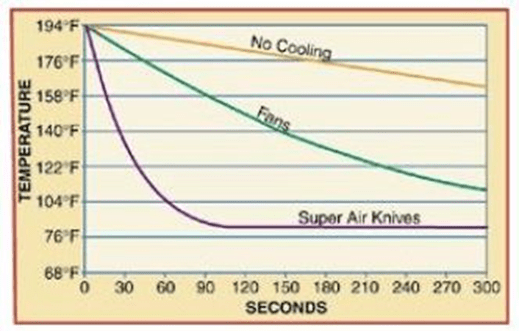You’ll often hear us refer to laminar vs turbulent flow when discussing our blowoff products. In any blowoff process or application, laminar airflow is going to be much more effective at cooling or drying than the turbulent airflow delivered by commonly found homemade blowoff devices or cheap knockoffs. To read more about the math behind it, check out my colleague John Ball’s previous post here.
Allow me to use the Super Air Knife to help illustrate the benefit of laminar vs turbulent flow. When a wide, even, laminar flow is necessary there isn’t a better option available on the market than EXAIR’s Super Air Knife. What really sets EXAIR’s Super Air Knife above the competition is the ability to maintain a consistent laminar flow across the full length of the knife compared to similar compressed air operated knives. This is even more evident when compared against blower operated knives or fans. A fan “slaps” the air, resulting in a turbulent airflow where the airflow particles are irregular and will interfere with each other. A laminar airflow, by contrast, will maintain smooth paths that will never interfere with one another.

The effectiveness of a laminar airflow vs turbulent airflow is particularly evident in the case of a cooling application for automotive computers coming out of a wave soldering machine. The chart below shows the time to cool computers to ambient temperatures for an automotive electronics manufacturer. They used a total of (32) 6” axial fans, (16) across the top and (16) across the bottom as the computers traveled along a conveyor. The computers needed to be cooled down before they could begin the testing process. By replacing the fans with just (3) Model 110012 Super Air Knives at a pressure of just 40 psig, the computers were cooled from 194°F down to 81° in just 90 seconds. The fans, even after 300 seconds still couldn’t remove enough heat to allow them to test.

Utilizing a laminar airflow is also critical when the airflow is being used to carry static eliminating ions further to the surface. Static charges can be both positive or negative. In order to eliminate them, we need to deliver an ion of the opposite charge to neutralize it. Since opposite charges attract, having a product that produces a laminar airflow to carry the ions makes the net effect much more effective. As you can see from the graphic above showing a turbulent airflow pattern vs a laminar one, a turbulent airflow is going to cause these ions to come into contact with one another. This neutralizes them before they’re even delivered to the surface needing to be treated. With a product such as the Super Ion Air Knife, we’re using a laminar airflow pattern to deliver the positive and negative ions. Since the flow is laminar, the total quantity of ions that we’re able to deliver to the surface of the material is greater. This allows the charge to be neutralized quickly, rather than having to sit and “dwell” under the ionized airflow.
With lengths from 3”-108” and (4) four different materials all available from stock, EXAIR has the right Super Air Knife for your application. In addition to shipping from stock, it’ll also come backed up by our unconditional 30-day guarantee. Test one out for yourself to see just how effective the Super Air Knife is on a wide variety of cooling, cleaning, or drying applications.
Tyler Daniel
Application Engineer
E-mail: TylerDaniel@exair.com
Twitter: @EXAIR_TD